Basilica of Saint-Denis
The Basilica of Saint-Denis (French: Basilique royale de Saint-Denis, or simply Basilique Saint-Denis) is a large medieval abbey church in the city of Saint-Denis, now a northern suburb of Paris. The building is of singular importance historically and architecturally as its choir, completed in 1144, shows the first use of all of the elements of Gothic architecture.
| Basilica of Saint-Denis | |
|---|---|
Basilique Saint-Denis | |
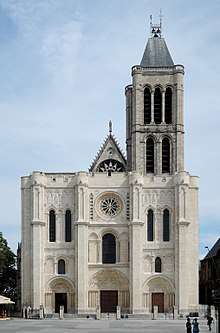 West façade of Saint-Denis | |
| Religion | |
| Affiliation | Roman Catholic |
| Province | Diocese of Saint-Denis |
| Ecclesiastical or organizational status | Cathedral |
| Leadership | Pascal Delannoy |
| Status | Active |
| Location | |
| Location | Saint-Denis, France |
| Geographic coordinates | 48°56′08″N 2°21′35″E |
| Architecture | |
| Type | Church |
| Style | Gothic |

The site originated as a Gallo-Roman cemetery in late Roman times. The archeological remains still lie beneath the cathedral; the people buried there seem to have had a faith that was a mix of Christian and pre-Christian beliefs and practices.[1] Around 475 St. Genevieve purchased some land and built Saint-Denys de la Chapelle. In 636 on the orders of Dagobert I the relics of Saint Denis, a patron saint of France, were reinterred in the basilica. The relics of St-Denis, which had been transferred to the parish church of the town in 1795, were brought back again to the abbey in 1819.[2]
The basilica became a place of pilgrimage and the burial place of the French Kings with nearly every king from the 10th to the 18th centuries being buried there, as well as many from previous centuries. (It was not used for the coronations of kings, that function being reserved for the Cathedral of Reims; however, French Queens were commonly crowned there.) "Saint-Denis" soon became the abbey church of a growing monastic complex.
In the 12th century, the Abbot Suger rebuilt portions of the abbey church using innovative structural and decorative features. In doing so, he is said to have created the first truly Gothic building.[3] The basilica's 13th-century nave is the prototype for the Rayonnant Gothic style, and provided an architectural model for many medieval cathedrals and abbeys of northern France, Germany, England and a great many other countries.
The abbey church became a cathedral in 1966 and is the seat of the Bishop of Saint-Denis, Pascal Michel Ghislain Delannoy. Although known as the "Basilica of St Denis", the cathedral has not been granted the title of Minor Basilica by the Vatican.[4]
The 86m high spire, dismantled in the nineteenth century, will be rebuilt. The project, initiated more than thirty years ago, will begin in May 2020. It should take about eleven years and cost 28 million euros.[5]
Background
Saint Denis, a patron saint of France, became the first bishop of Paris. He was decapitated on the hill of Montmartre in the mid-third century with two of his followers, and is said to have subsequently carried his head to the site of the current church, indicating where he wanted to be buried. A martyrium was erected on the site of his grave, which became a famous place of pilgrimage during the fifth and sixth centuries.[2]
Dagobert's church
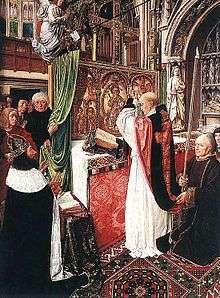
Dagobert, the king of the Franks (reigned 628 to 637), refounded the church as the Abbey of Saint Denis, a Benedictine monastery. Dagobert also commissioned a new shrine to house the saint's remains, which was created by his chief councillor, Eligius, a goldsmith by training. An early vita of Saint Eligius describes the shrine:
- Above all, Eligius fabricated a mausoleum for the holy martyr Denis in the city of Paris with a wonderful marble ciborium over it marvelously decorated with gold and gems. He composed a crest [at the top of a tomb] and a magnificent frontal and surrounded the throne of the altar with golden axes in a circle. He placed golden apples there, round and jeweled. He made a pulpit and a gate of silver and a roof for the throne of the altar on silver axes. He made a covering in the place before the tomb and fabricated an outside altar at the feet of the holy martyr. So much industry did he lavish there, at the king's request, and poured out so much that scarcely a single ornament was left in Gaul and it is the greatest wonder of all to this very day.[7]
None of this work survives.

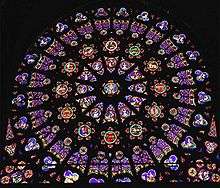
Architecture
The Basilica of St Denis ranks as an architectural landmark—as the first major structure of which a substantial part was designed and built in the Gothic style.[8] Both stylistically and structurally, it heralded the change from Romanesque architecture to Gothic architecture. Before the term "Gothic" came into common use, it was known as the "French Style" (Opus Francigenum).
As it now stands, the church is a large cruciform building of "basilica" form; that is, it has a central nave with lower aisles and clerestory windows. It has an additional aisle on the northern side formed of a row of chapels. The west front has three portals, a rose window and one tower, on the southern side. The eastern end, which is built over a crypt, is apsidal, surrounded by an ambulatory and a chevet of nine radiating chapels. The basilica retains stained glass of many periods (although most of the panels from Suger's time have been removed for long-term conservation and replaced with photographic transparencies), including exceptional modern glass, and a set of twelve misericords. The basilica measures 108 meters long, and its width is 39 meters.
The Carolingian church
Little is known about the earliest buildings on the site. The first church mentioned in the chronicles was begun in 754 under Pepin the Short and completed under Charlemagne, who was present at its consecration in 775. By 832 the Abbey had been granted a remunerative whaling concession on the Cotentin Peninsula.[9] Most of what is now known about the Carolingian church at St Denis resulted from a lengthy series of excavations begun under the American art historian Sumner McKnight Crosby in 1937.[10] The building was about 60m long, with a monumental westwork, single transepts, a crossing tower and a lengthy eastern apse over a large crypt (parts of which survive). According to one of the Abbey's many foundation myths a leper, who was sleeping in the nearly completed church the night before its planned consecration, witnessed a blaze of light from which Christ, accompanied by St Denis and a host of angels, emerged to conduct the consecration ceremony himself. Before leaving, Christ healed the leper, tearing off his diseased skin to reveal a perfect complexion underneath. A misshapen patch on a marble column was said to be the leper's former skin, which stuck there when Christ discarded it. Having been consecrated by Christ, the fabric of the building was itself regarded as sacred.[11]
The Early Gothic Rebuilding
Abbot Suger (c. 1081 – 1151), friend and confidant of French kings and Abbot of St Denis from 1122, began work around 1135 on rebuilding and enlarging the abbey to which he had been given as an oblate at the age of 10. In his famous account of the work undertaken during his administration, Suger was careful to explain and justify his decision to rebuild the church, complaining at length about the parlous state of the old structure and its inability to cope with the crowds of pilgrims visiting the shrine of St Denis, particularly
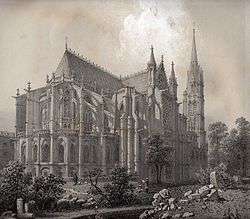
...on special days such as the feast of the blessed Denis [...] when the narrowness of the place forced women to run to the altar on the heads of men as on a pavement with great anguish and confusion.[12]
Suger's fascination with light was not merely aesthetic. Like many French clerics in the 12th century AD, he was a follower of Pseudo-Dionysius the Areopagite, a 6th-century mystic who equated the slightest reflection or glint with divine light. When renovated, the Saint-Denis basilica included Suger's own words carved in the nave: "For bright is that which is brightly coupled with the bright/and bright is the noble edifice which is pervaded by the new light."[13]
It is important to emphasise that Suger was the patron of the rebuilding of St Denis but not the architect, as was often assumed in the 19th and early 20th centuries.[14] In fact it appears that two distinct architects, or master masons, were involved in the 12th-century changes. Both remain anonymous but their work can be distinguished on stylistic grounds. The first, who was responsible for the initial work at the western end, favoured conventional Romanesque capitals and moulding profiles with rich and individualised detailing. His successor, who completed the western facade and upper stories of the narthex, before going on to build the new choir, displayed a more restrained approach to decorative effects, relying on a simple repertoire of motifs, which may have proved more suitable for the lighter Gothic style that he helped to create.[15]
First Phase: the west front, c. 1135–1140
Suger began his rebuilding project at the western end of St Denis, demolishing the old Carolingian westwork, with its single, centrally located door. He extended the old nave westwards by an additional four bays and added a massive western narthex, incorporating a new façade and three chapels on the first floor level. This new façade, 34 metres (112 ft) wide and 20 metres (66 ft) deep, has three portals, the central one larger than those either side, reflecting the relative width of the central nave and lateral aisles. This tripartite arrangement was clearly influenced by the late 11th-century façades of the abbey churches of St Etienne and La Trinité, Caen, with which it also shared a three-story elevation and flanking towers. Only the south tower survives; the north tower was dismantled following a tornado which struck in 1846.
The major innovation in the façade at St Denis is the way the unknown architects have chosen to emphasise the divisions between the different parts with massive vertical buttresses separating the three doorways and horizontal string-courses and window arcades clearly marking out the divisions. This clear delineation of parts was to influence subsequent west façade designs as a common theme in the development of Gothic architecture and a marked departure from the Romanesque. The rose window at the centre of the upper story of the west portal was also innovative and influential. Although small circular windows (oculi) within triangular tympana were common on the west facades of Italian Romanesque churches, this was probably the first example of a rose window within a square frame, which was to become a dominant feature of the Gothic facades of northern France (soon to be imitated at Chartres Cathedral and many others).[16] The overall design of the façade has an obvious resemblance to a Roman city gatehouse (an impression strengthened by the buttresses and by the crenellations around the top), which helps to emphasise the traditional notion of great churches as earthly embodiments of the Heavenly City, as described in the Book of Ezekiel.
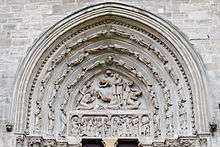
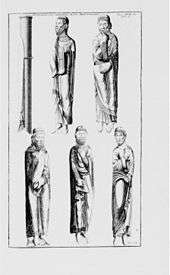
The many influential features of the new façade include the tall, thin statues of Old Testament prophets and kings attached to columns (jamb figures) flanking the portals (destroyed in 1771 but recorded in Montfaucon's drawings). These were also adopted at the cathedrals of Paris and Chartres, constructed a few years later, and became a feature of almost every Gothic portal thereafter. Above the doorways, the central tympanum was carved with Christ in Majesty displaying his wounds with the dead emerging from their tombs below. Scenes from the martyrdom of St Denis were carved above the south (right hand) portal, while above the north portal was a mosaic (lost), even though this was, as Suger put it 'contrary to the modern custom'. Of the original sculpture, very little remains, most of what is now visible being the result of rather clumsy restoration work in 1839.[17] Some fragments of the original sculptures survive in the collection of the Musée de Cluny. The portals themselves were sealed by gilded bronze doors, ornamented with scenes from Christ's Passion and clearly recording Suger's patronage with the following inscription;
For the glory of the church which nurtured and raised him, Suger strove for the glory of the church, Sharing with you what is yours, oh martyr Denis. He prays that by your prayers he should become a sharer in Paradise. The year when it was consecrated was the one thousand, one hundred and fortieth year of the Word.[18]
On the lintel below the great tympanum showing the Last Judgement, beneath a carved figure of the kneeling Abbot, was inscribed the more modest plea;
Receive, stern Judge, the prayers of your Suger, Let me be mercifully numbered among your sheep.
Suger's western extension was completed in 1140 and the three new chapels in the narthex were consecrated on 9 June of that year.
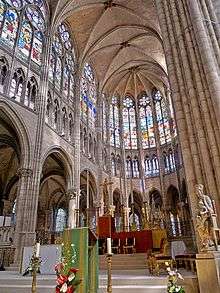
Second Phase: the new choir, 1140–1144
On completion of the west front, Abbot Suger moved on to the reconstruction of the eastern end, leaving the Carolingian nave in use. He wanted a choir (chancel) that would be suffused with light. To achieve his aims, Suger's masons drew on the several new elements which evolved or had been introduced to Romanesque architecture: the pointed arch, the rib vault, the ambulatory with radiating chapels, the clustered columns supporting ribs springing in different directions and the flying buttresses which enabled the insertion of large clerestory windows.
It was the first time that these features had all been drawn together, and the style evolved radically from the previous Romanesque architecture by the lightness of the structure and the unusually large size of the stained glass windows.
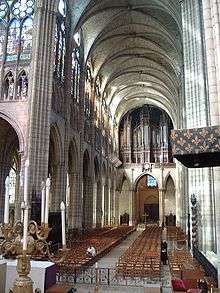
The new structure was finished and dedicated on 11 June 1144, in the presence of the King.[19] The Abbey of St Denis thus became the prototype for further building in the royal domain of northern France. Through the rule of the Angevin dynasty, the style was introduced to England and spread throughout France, the Low Countries, Germany, Spain, northern Italy and Sicily.[20][21]
Reconstruction of the Nave
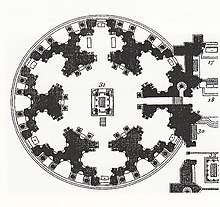
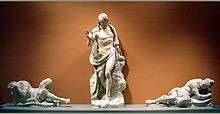
%2C_basilique_Saint-Denis%2C_abside_3.jpg)
In 1231, Abbot Odo Clement began work on the rebuilding of the Carolingian nave, which remained sandwiched incongruously between Suger's Gothic works to the east and west. Both the nave and the upper parts of Suger's choir were replaced in the Rayonnant Gothic style. From the start it appears that Abbot Odo, with the approval of the Regent Blanche of Castile and her son, the young King Louis IX, planned for the new nave and its large crossing to have a much clearer focus as the French 'royal necropolis'. That plan was fulfilled in 1264 when the bones of 16 former kings and queens were relocated to new tombs arranged around the crossing, eight Carolingian monarchs to the south and eight Capetians to the north.[22] These tombs, featuring lifelike carved recumbent effigies or gisants lying on raised bases, were badly damaged during the French revolution though all but two were subsequently restored by Viollet le Duc in 1860.
The dark Romanesque nave, with its thick walls and small window-openings, was rebuilt using the very latest techniques, in what is now known as Rayonnant Gothic. This new style, which differed from Suger's earlier works as much as they had differed from their Romanesque precursors, reduced the wall area to an absolute minimum. Solid masonry was replaced with vast window openings filled with brilliant stained glass (all destroyed in the Revolution) and interrupted only by the most slender of bar tracery—not only in the clerestory but also, perhaps for the first time, in the normally dark triforium level. The upper facades of the two much-enlarged transepts were filled with two spectacular 12m-wide rose windows.[23] As with Suger's earlier rebuilding work, the identity of the architect or master mason remains unknown. Although often attributed to Pierre de Montreuil, the only evidence for his involvement is an unrelated document of 1247 which refers to him as 'a mason from Saint-Denis'.[24]
The Valois Mortuary Chapel
A plan of circa 1700 by Félibien shows the Valois Chapel, a large mortuary chapel in the form of a domed colonnaded "rotunda", adjoining the north transept of the basilica and containing the tomb of the Valois.[25]
St. Denis and the French Revolution
Due to its connections to the French monarchy and proximity to Paris, the abbey of Saint-Denis was a prime target of revolutionary vandalism. The medieval monastic buildings were demolished in 1792. Although the church itself was left standing, it was deconsecrated, its treasury confiscated and its reliquaries and liturgical furniture melted down for their metallic value (although some objects, including a chalice and aquamanile donated to the abbey in Suger’s time, were successfully hidden and survive to this day) and the royal tombs desecrated. The jamb figures of the façade representing Old Testament royalty, mistakenly identified as images of royal French kings and queens, were removed from the portals and the tympana sculpture defaced. The tombs and effigies were relocated to the Musée des Monuments Français by Alexandre Lenoir in 1798.
The church was reconsecrated by Napoléon in 1806 and the tomb sculptures returned to Saint-Denis after the restoration of the monarchy. The church, including the architectural sculpture and stained glass windows (of which very little medieval glass survives) was heavily restored in the mid-nineteenth century by Eugène Viollet-le-Duc, the same architect responsible for the restoration of the Cathedral of Notre-Dame. The present location of the tomb effigies does not correspond to their medieval locations.[26]
Removal and reconstruction of the north tower
In the early 1840s, cracks appeared in the north tower's masonry following several extreme weather events. A violent storm on 19 August 1845, notable for spawning a tornado, proved critical, and the tower's walls were soon found to have flexed and become dangerously unstable. With François Debret's reconstructive works, carried out after an 1837 lightning strike, proving inadequate, in February 1846 the authorities decided to "temporarily" dismantle the north tower to avoid a catastrophic collapse, with the stones stored for later reconstruction.[27]
In December 2016, 170 years after the North Tower's dismantlement and following several false starts, the Ministry of Culture again proposed its reconstruction after concluding it was technically feasible—albeit without public funding.[28] An association, Suivez la flèche ("Follow the Spire"), chaired by Patrick Braouezec, has since been established to support the reconstruction, with the aim of raising the necessary funds by opening the reconstruction works to the general public, along the model of the Guédelon Castle. In March 2018 the culture ministry signed an accord with the association, officially launching the reconstruction project, with works expected to commence in May 2020.[29][5]
Burial site
The abbey is where the kings of France and their families were buried for centuries and is therefore often referred to as the "royal necropolis of France".[30] All but three of the monarchs of France from the 10th century until 1789 have their remains here. Some monarchs, like Clovis I (465–511), were not originally buried at this site. The remains of Clovis I were exhumed from the despoiled Abbey of St Genevieve which he founded.
The abbey church contains some fine examples of cadaver tombs. The effigies of many of the kings and queens are on their tombs, but their bodies were removed during the French Revolution. The ancient monarchs were removed in August 1793 to celebrate the revolutionary Festival of Reunion, then the Bourbon and Valois monarchs were removed to celebrate the execution of Marie Antoinette in October 1793. The bodies were dumped into three trenches and covered with lime to destroy them.[31] Archaeologist Alexandre Lenoir saved many of the monuments by claiming them as artworks for his Museum of French Monuments. The bodies of several Plantagenet monarchs of England were likewise removed from Fontevraud Abbey during the French Revolution.
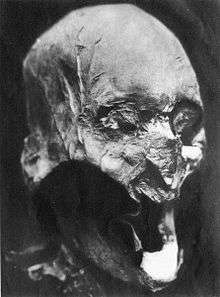
Napoleon Bonaparte reopened the church in 1806, but left the royal remains in their mass graves. In 1817 the restored Bourbons ordered the mass graves to be opened, but only portions of three bodies remained intact. The remaining bones from 158 bodies were collected into an ossuary in the crypt of the church, behind marble plates bearing their names.[31]
Bourbon crypt
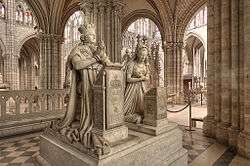
The bodies of the beheaded King Louis XVI, his wife Marie Antoinette of Austria, and his sister Madame Élisabeth were not initially buried in Saint-Denis, but rather in the churchyard of the Madeleine, where they were covered with quicklime. The body of the Dauphin, who died of illness and neglect at the hands of his revolutionary captors, was buried in an unmarked grave in a Parisian churchyard near the Temple. During Napoleon's exile in Elba, the restored Bourbons ordered a search for the corpses of Louis XVI and Marie Antoinette. The few remains, a few bones that were presumably the king's and a clump of greyish matter containing a lady's garter, were found on 21 January 1815, brought to Saint-Denis and buried in the new Bourbon crypt.
King Louis XVIII, upon his death in 1824, was buried in the center of the crypt, near the graves of Louis XVI and Marie Antoinette. The coffins of royal family members who died between 1815 and 1830 were also placed in the vaults. Under the direction of architect Viollet-le-Duc, famous for his work on Notre-Dame de Paris, church monuments that had been taken to the Museum of French Monuments were returned to the church. The corpse of King Louis VII, who had been buried at Barbeau Abbey and whose tomb had not been touched by the revolutionaries, was brought to Saint-Denis and buried in the crypt. In 2004, the mummified heart of the Dauphin, the boy who would have been Louis XVII, was sealed into the wall of the crypt.
Furniture
Organ
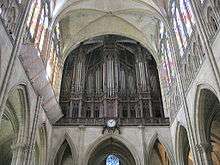
The organ of the Basilica of Saint-Denis was the first organ built by Aristide Cavaillé-Coll in 1841, when he was 23 years old. It contains numerous innovations opening the romantic area, in particular the very first Barker lever. With 3 manuals and pedals, it is protected by the Monument historique label. It was restored in 1901 by Charles Mutin, and between 1983 and 1987 by Jean-Loup Boisseau and Bertrand Cattiaux. Pierre Pincemaille, sole titular organist for 30 years (between 1987 and 2018), held many recitals (between 1989 and 1995, then between 2014 and 2017), and recorded 8 CDs with this instrument.
In March, 2019 an unknown intruder damaged the organ, causing extensive damage to the pump motor and doors leading to the internal area of the organ, as well as to a nearby stained glass window.[32]
Treasure
The cathedral contains a huge church treasure, mainly constituted by the Abbot Suger. It contains crowns (Charlemagne, Saint Louis, Henry IV of France), cross and liturgic objects.
Burials

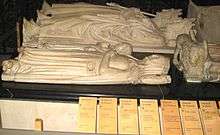
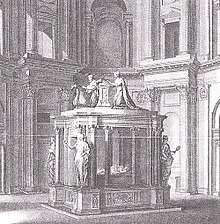
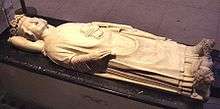
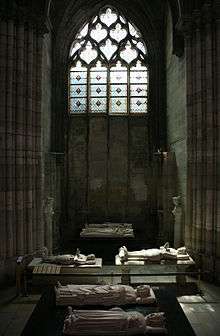

Kings
All but three of the Kings of France were buried in the basilica, as well as a few other monarchs. The remains of the earlier monarchs were removed from the destroyed Abbey of St Genevieve. Some of the most prominent of these are:
- Clovis I (466–511)
- Childebert I (496–558)
- Aregund (515/520–580)
- Fredegund (third wife of Chilperic I), (died 597)
- Dagobert I (603–639)
- Clovis II (634–657)
- Charles Martel (686–741)
- Pepin the Short (714–768) and his wife, Bertrada of Laon (born 710–727, died 783)
- Carloman I (751–771)
- Charles the Bald (823–877) (his brass monument was melted down during the Revolution) and his first wife, Ermentrude of Orléans (823–869)
- Carloman II (866–884)
- Robert II of France (972–1031) and his third wife, Constance of Arles (986–1032)
- Henry I of France (1008–1060)
- Louis VI of France (1081–1137)
- Louis VII of France (1120–1180) and his second wife, Constance of Castile (1140–1160)
- Philip II of France (1165–1223)
- St. Louis IX of France (1214–1270)
- Charles I of Naples (1227–1285), an effigy covers his heart burial
- Philip III of France (1245–1285) and his first wife, Isabella of Aragon, Queen of France (1248–1271)
- Philip IV of France (1268–1314)
- Leo V, King of Armenia (1342–1393)
- Charles VII, King of France (1403–1461)
- Charles VIII, King of France (1470–1498)
- Louis XII of France (1462–1515)
- Francis I of France (1494–1547)
- Henry II (1519–1559) and Catherine de' Medici (1519–1589)
- Francis II (1544–1560)
- Charles IX (1550–1574) (no monument)
- Henry III (1551–1589), also King of Poland (heart burial monument)
- Henry IV (1553–1610)
- Louis XIII (1601–1643)
- Louis XIV (1638–1715)
- Louis XV (1710–1774),
- Louis XVI (1754–1793) and Marie Antoinette (1755–1793)
- Louis XVII (1785–1795) (only his heart; his body was dumped into a mass grave)
- Louis XVIII (1755–1824)
Other royalty and nobility
- Blanche of France (daughter of Philip IV)
- Nicolas Henri, Duke of Orléans (1607–1611), son of Henry IV
- Gaston, Duke of Orléans (1608–1660), son of Henry IV
- Marie de Bourbon, Duchess of Montpensier (1605–1627), wife of Gaston
- Marguerite of Lorraine (1615–1672), Duchess of Orléans and second wife of Gaston
- Anne Marie Louise d'Orléans (1627–1693), la Grande Mademoiselle
- Marguerite Louise d'Orléans (1645–1721), Grand Duchess of Tuscany
- Jean Gaston d'Orléans (1650–1652), Duke of Valois
- Marie Anne d'Orléans (1652–1656), Mademoiselle de Chartres
- Henrietta Maria of France (1609–1669), wife of Charles I of Scotland and England
- Philippe I, Duke of Orléans (1640–1701), brother of Louis XIV
- Princess Henrietta of England (1644–1670), first wife of Philippe
- Elisabeth Charlotte of the Palatinate (1652–1722), second wife of Philippe
- Maria Theresa of Spain (1638–1683), consort of Louis XIV
- Louis of France (1661–1711), le Grand Dauphin
- Maria Anna Victoria of Bavaria (1660–1690), Dauphin of France, wife of Louis
- Princess Anne Élisabeth of France (1662), daughter of Louis XIV
- Princess Marie Anne of France (1664), daughter of Louis XIV
- Marie Thérèse of France (1667–1672), daughter of Louis XIV
- Philippe Charles, Duke of Anjou (1668–1671), Duke of Anjou, son of Louis XIV
- Louis François of France (1672), Duke of Anjou, son of Louis XIV
- Philippe II, Duke of Orléans (1674–1723), Regent of France
- Louis of France (1682–1712), Duke of Burgundy
- Marie Adélaïde of Savoy (1685–1712), Duchess of Burgundy
- Louis of France (1704–1705), Duke of Brittany
- Louis of France (1707–1712), Duke of Brittany
- Charles of France (1686–1714), Duke of Berry
- Marie Louise Élisabeth d'Orléans (1695–1719), Duchess of Berry
- Na (not baptized) d'Alençon (1711)
- Charles d'Alençon(1713) Duke of Alençon
- Marie Louise Élisabeth d'Alençon (1714)
- Marie Leszczyńska (1703–1768), consort of Louis XV
- Louise Élisabeth of France (1727–1759), Duchess of Parma
- Henriette of France (1727–1752), daughter of Louis XV and twin of the above
- Louise of France (1728–1733), daughter of Louis XV
- Louis of France (1729–1765), Dauphin of France
- Infanta Maria Teresa Rafaela of Spain (1726–1746), first wife of above
- Maria Josepha of Saxony (1731–1767), second wife of Louis
- Philippe of France (1730–1733), Duke of Anjou
- Princess Marie Adélaïde of France (1732–1800), daughter of Louis XV
- Princess Victoire of France (1733–1799), daughter of Louis XV
- Princess Sophie of France (1734–1782), daughter of Louis XV
- Princess Louise of France (1737–1787), daughter of Louis XV,
- Louis Joseph, Dauphin of France (1781–1789), first son of Louis XVI and Marie Antoinette
- Princess Sophie Hélène Béatrice of France (1786–1787), second daughter of Louis XVI and Marie Antoinette
- Henri de La Tour d'Auvergne, Vicomte de Turenne (1611–1675), Maréchal General de France.
- Anne of Brittany, Duchess of Brittany (1477–1514), wife of Charles VIII and Louis XII.
Gallery
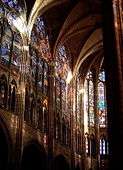 The choir at sunset
The choir at sunset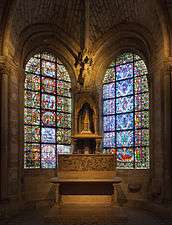 The axial chapel of the Virgin
The axial chapel of the Virgin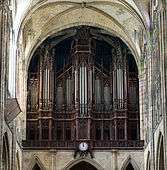 The pipe organ
The pipe organ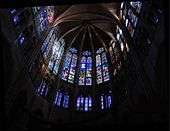 The clerestory windows
The clerestory windows Tomb of Dagobert I
Tomb of Dagobert I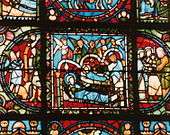 Detail from the 12th-century Life of Christ window
Detail from the 12th-century Life of Christ window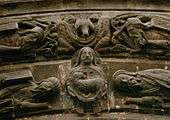 Depiction of the Trinity over the main entrance
Depiction of the Trinity over the main entrance Fulrad, Abbot of Saint-Denis
Fulrad, Abbot of Saint-Denis
See also
- Gothic cathedrals and churches
- Cathedral diagram
- Martyrium of Saint Denis, Montmartre
References and sources
References
- A grave from the exterior necropolis
- Catholic Encyclopedia: Abbey of Saint-Denis
- Banister Fletcher, A History of Architecture on the Comparative Method.
- Basilicas of France.
- "Saint Denis Cathedral spire". Paris Digest. 2019. Retrieved 2019-04-30.
- "Birth of the Gothic: Abbot Suger and the Ambulatory at St. Denis". Smarthistory at Khan Academy. Retrieved December 18, 2012.
- Vita S. Eligius, edited by Levison, on-line at Medieval Sourcebook
- Honour, H. and J. Fleming, (2009) A World History of Art. 7th edn. London: Laurence King Publishing, p. 376. ISBN 9781856695848
- DeSmet, W.M.A. (1981). "Mammals in the Seas: General papers and large cetaceans. Whaling During the Middle Ages". Cite journal requires
|journal=(help) - Sumner McKnight Crosby, The Royal Abbey of Saint-Denis from Its Beginnings to the Death of Suger, 475–1151, Yale University Press, 1987
- Lindy Grant, Abbot Suger of St.Denis: Church and State in Early Twelfth-century France, Longman, 1998
- Fordham College Medieval Sourcebook, "Abbot Suger: ON WHAT WAS DONE IN HIS ADMINISTRATION", Chapter XXV: Concerning the First Addition to the Church
- Bruce Watson, Light: A Radiant History from Creation to the Quantum Age. Bloomsbury, 2016, p 52.
- Lindy Grant, Abbot Suger of St. Denis: Church and State in Early Twelfth-Century France, Addison Wesley Longman Limited, 1998
- Stephen Gardner, "Two Campaigns in Suger's Western Block at Saint-Denis", Art Bulletin, Vol.44, part 4, 1984, pp. 574–87
- William Chester Jordan, A Tale of Two Monasteries: Westminster and Saint-Denis in the thirteenth century (Princeton: Princeton University Press, 2009) Chapters 2–7.
- . Pamela Blum, Early Gothic Saint-Denis: Restorations and Survivals, Berkeley, 1992
- Fordham College Medieval Sourcebook, "Abbot Suger: ON WHAT WAS DONE IN HIS ADMINISTRATION", Chapter XXVII: Concerning the Cast and Gilded Doors
- H. Honour and J. Fleming, The Visual Arts: A History. Upper Saddle River, NJ: Pearson Prentice Hall, 2005. ISBN 0-13-193507-0
- "L'art Gothique", section: "L'architecture Gothique en Angleterre" by Ute Engel: L'Angleterre fut l'une des premieres régions à adopter, dans la deuxième moitié du XIIeme siècle, la nouvelle architecture gothique née en France. Les relations historiques entre les deux pays jouèrent un rôle prépondérant: en 1154, Henri II (1154–1189), de la dynastie Française des Plantagenêt, accéda au thrône d'Angleterre." (England was one of the first regions to adopt, during the first half of the 12th century, the new Gothic architecture born in France. Historic relationships between the two countries played a determining role: in 1154, Henry II (1154–1189), of the French Plantagenet dynasty, ascended to the throne of England).
- John Harvey, The Gothic World
- Georgia Sommers Wright, "A Royal Tomb Program in the Reign of St Louis", in The Art Bulletin, Vol.56, No.2 (Jun 1974) pp.224–43
- Christopher Wilson, The Gothic Cathedral: The Architecture of the Great Church 1130–1530, Thames & Hudson, 1992
- Caroline Bruzelius, The Thirteenth-century Church at St-Denis, New Haven, 1985
- Images of Medieval Art and Architecture – Félibien accessed March 29, 2009
- http://www.aviewoncities.com/paris/basiliquesaintdenis.htm
- "L'affaire de la tour nord : La querelle des anciens et des modernes". Basilique Cathédrale de Saint-Denis (in French). Seine-Saint-Denis Tourisme. Retrieved 26 September 2018.
- Bourdon, Gwenaël (30 January 2017). "Basilique Saint-Denis : le chantier de la flèche freiné dans son élan". Le Parisien (in French). Retrieved 26 September 2018.
- "Accord définitif de l'Etat : la flèche de la Basilique sera remontée". Basilique Cathédrale de Saint-Denis (in French). Seine-Saint-Denis Tourisme. Retrieved 26 September 2018.
- "Basilique Cathédrale de Saint-Denis". Centre des Monuments Nationaux.
Come and visit the Basilica Cathedral of Saint Denis near Paris, the first monumental masterpiece of Gothic art. Discover the Royal necropolis and its collection of 70 sculpted recumbent statues – the only set of its kind in Europe – bathed in the multi-coloured light of the 12th and 19th-century stained glass windows.
- Lindsay, Suzanne Glover. "The Revolutionary Exhumations at St-Denis, 1793". Center for the Study of Material & Visual Cultures of Religion. Yale University.
- N.R.; CS (5 March 2019). "Saint-Denis : l'orgue de la basilique dégradé après une intrusion". Le Parisien (in French). Retrieved 15 April 2020.
- Knecht, 227. Henry's gesture is now unclear, since a missal, resting on a prie-dieu (prayer desk), was removed from the sculpture during the French revolution and melted down.
Sources
- Félibien, Michel. 1973. Histoire de l'abbaye royale de Saint-Denys en France: Lettre-préf. de M. le Duc de Bauffremont. Introd. de Hervé Pinoteau. 1. [Nachdr. d. Ausg. Paris, 1706]. – 1973. – 524 S. Paris: Éd. du Palais Royal.
- Saint-Denis Cathedral, Alain Erlande-Brandenburg, Editions Ouest-France, Rennes
Further reading
- Gerson, Paula Lieber. (1986). Abbot Suger and Saint-Denis: a symposium, New York: The Metropolitan Museum of Art. ISBN 9780870994081
- Conrad Rudolph, Artistic Change at St-Denis: Abbot Suger's Program and the Early Twelfth-Century Controversy over Art (1990)
- Conrad Rudolph, "Inventing the Gothic Portal: Suger, Hugh of Saint Victor, and the Construction of a New Public Art at Saint-Denis," Art History 33 (2010) 568–595
- Conrad Rudolph, "Inventing the Exegetical Stained-Glass Window: Suger, Hugh, and a New Elite Art," Art Bulletin 93 (2011) 399–422
- Watson, Bruce, Light: A Radiant History from Creation to the Quantum Age, (London and NY: Bloomsbury, 2016).
External links
| Wikimedia Commons has media related to |
- Detailed list of members of the French Royal families buried in Saint-Denis Basilica
- Map of the tombs in Saint-Denis Basilica
- The Treasures of Saint-Denis – scholarly article from 1915 on the important and mostly destroyed treasures
- L'Internaute Magazine: Diaporama (in French)
- Satellite image from Google Maps
- Saint-Denis, a town in the Middle Ages
- Photos of tombs and the Basilica (in French)
- history and pictures of the Basilica (in French)
- Presentation of the organ of the Cathedral-Basilica of Saint-Denis by Pierre Pincemaille, titular organist on YouTube (in French) – With English subtitles.
- The Sumner McKnight Crosby Papers from The Cloisters Library, The Metropolitan Museum of Art, New York.
